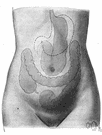transverse colon
n.
The part of the colon that lies across the upper part of the abdominal cavity.
American Heritage® Dictionary of the English Language, Fifth Edition. Copyright © 2016 by Houghton Mifflin Harcourt Publishing Company. Published by Houghton Mifflin Harcourt Publishing Company. All rights reserved.
transverse colon
n
(Anatomy) anatomy the part of the large intestine passing transversely in front of the liver and stomach
Collins English Dictionary – Complete and Unabridged, 12th Edition 2014 © HarperCollins Publishers 1991, 1994, 1998, 2000, 2003, 2006, 2007, 2009, 2011, 2014
trans′verse co′lon
(ˈkoʊ lən)n.
the middle portion of the colon, lying across the upper abdominal cavity between the ascending colon and the descending colon.
Random House Kernerman Webster's College Dictionary, © 2010 K Dictionaries Ltd. Copyright 2005, 1997, 1991 by Random House, Inc. All rights reserved.
ThesaurusAntonymsRelated WordsSynonymsLegend:
| Noun | 1. |  transverse colon - the part of the large intestine that extends across the abdominal cavity and joins the ascending to the descending colon transverse colon - the part of the large intestine that extends across the abdominal cavity and joins the ascending to the descending colonlarge intestine - beginning with the cecum and ending with the rectum; includes the cecum and the colon and the rectum; extracts moisture from food residues which are later excreted as feces |
Based on WordNet 3.0, Farlex clipart collection. © 2003-2012 Princeton University, Farlex Inc.